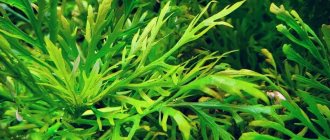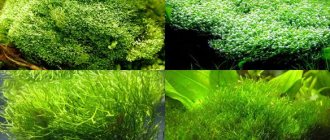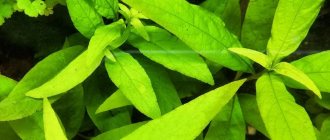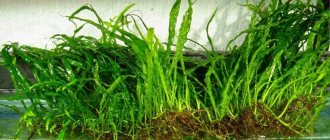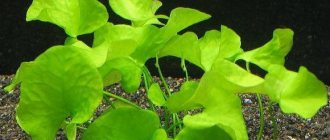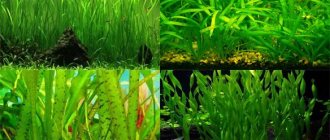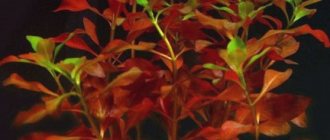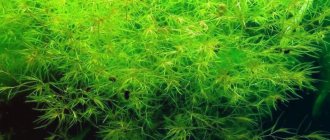Hygrophila pinnatifida is familiar to many aquarists around the world. This is a unique plant, characterized by ease of care and high decorative qualities. And if other species of plants of this genus are long-stemmed , then Hygrophila pinnatifida is very different from its relatives. The contents of this aquarium plant will be discussed in more detail in this article.
Hygrophila pinnatifida
Description
Hygrophila pinnatifida belongs to the Acanthaceae family. People first started talking about the plant about 100 years ago, but they began to actively use it in aquarium farming relatively recently - just over 20 years ago. Although even now Hygrophila does not belong to the group of widespread plants, because not in every aquarium you can see this unique plant.
Hygrophila pinnatifida belongs to the Acanthaceae family
So what is the peculiarity of the aquarium plant and why is it so attractive to aquarists? First of all, this is the plant’s ability to grow not only in soil , but also in snags or stones. After new shoots appear on the parent plant, growth points appear at the points of contact between the internodes and the ground. As a result, new stems with leaves appear that grow vertically upward. The leaves look very beautiful and have high decorative qualities.
Note! Hygrophiles pinnatifidae are also actively used in nano-aquariums due to their small size.
Diseases
- The leaves have turned green. This means that Hygrophila does not have enough lighting. In this case, it is necessary to increase the lighting to 1.2 W/l and add CO2;
- The old leaves are all full of holes, as if from a needle. There is not enough potassium in the water, otherwise the leaves would bloom without damage. You can add CO2 in the range of 6 to 7 mg/liter. If you start the disease, the plant will quickly begin to shed its old leaves, and the new leaves will be very tiny;
- Many vertical stems and flying lower leaves. Again, there is not enough lighting;
- The leaves have become brittle. Probably, you went too far with the water hardness. Reduce temporary hardness to 12°dGH to allow leaves to recover;
- The leaves have turned yellow. The plant lacks iron, increase its saturation to 0.7 mg/liter.
Conclusion
Growing and caring for Hygrophila Pinnatifida requires moderately advanced aquarist skills: the ability to “adjust” water acidity and light intensity. In general, the plant grows independently without problems and requires only potassium and good light. A special advantage is its unhurried growth, which allows you to preserve the composition in the aquarium for a long time. Therefore, it is used for both large and small aquariums.
This algae is also happily grown in open aquaspaces, farms and greenhouses (yes, it also grows on land). It is often an element in compositions exhibited at aquarium competitions, for example, AquaSet: Aquatic Scapers Europe.
In addition to its external advantages, Hygrophila Pinnatifida has a useful property: it absorbs nitrates in water and helps the development of a favorable ecosystem.
Watch a video about Hygrophilus pinnatifida:
What does the plant look like?
Hygrophila pinnatifida has stiff stems with a brown tint. The average height of the plant is 13-15 cm, but in some cases it can grow to larger sizes (up to 40 cm). Of course, optimal conditions must be provided for this. The leaves look very aesthetically pleasing and grow in pairs. If at first the internodes are small and almost invisible, then over time they become quite large.
What does Hygrophila pinnatifida look like?
The leaves are quite long and thin (can grow up to 15 cm in length), have an unusual dissection, which makes the plant very attractive. Leaf color is variable and can vary from pink to brown. It depends on the conditions of detention. The plant attracts many aquarists precisely due to its unusual leaves.
The plant has unusual leaves
Content
There is no need to perform particularly difficult manipulations for the maintenance and normal development of Hydrocotyle tripartita.
The vast majority of specialists in the aquarium hobby confidently declare that the stinkhorn is an unpretentious aquatic plant. But there are still some recommendations. Although hydrocotyla is a slow-growing representative of the flora, the mustache with leaves, if not trimmed, can gradually occupy the entire space of the aquarium.
In order not to bring the situation to an extreme, excess shoots are either pinched off or trimmed with scissors.
If you set a goal, then in this way inside the aquarium you can create a beautiful bright green hemisphere with a height at the top point of up to 7 cm.
The optimal temperature of the aquatic environment for keeping scutellum is the same as when planting. Although a temperature of +20 degrees is suitable for hydrocotyle. Typically, this mode is maintained if the aquarium contains cold-water fish. True, Hydrocotyle tripartita will grow a little slower.
The plant can be slightly fed with standard liquid mineral fertilizers containing a complex of micronutrients at the rate of 1 g of fertilizer per 100 liters of water.
There is also a requirement for water hardness, that is, for the concentration of magnesium, calcium and ferrous iron cations in it. If a hardness of 1 to 7 degrees is considered optimal for keeping rosehip, then at a hardness of 12 degrees the plant may die.
In muddy water, this aquatic vegetation feels extremely uncomfortable. Its leaves first bend downwards, the leaves and tendrils begin to deteriorate, and if measures are not taken, the stinkhorn may even die.
Therefore, the recommended 20 percent water change must be done weekly.
We should not forget about effective aeration.
For the normal existence of hydrocotyla tripartita, normal lighting is also necessary. Therefore, it is recommended to combine a fluorescent lamp and an ordinary incandescent light bulb. Light must penetrate into the aquarium for at least 12 hours a day. This way you will get lush vegetation quite quickly.
Dense bright green thickets of hydrocotyla can often be seen in home and office aquariums, where they not only serve as a decorative element, but are also active participants in the natural biochemical processes that constantly occur in the water.
The unpretentiousness and ease of keeping this plant allow even beginners in the aquarium business to successfully breed it in artificial reservoirs.
Where does it live?
Hygrophila pinnatifida was first identified in India, which is why this country is its homeland. Most often, the plant can be found in shallow streams that flow at the foot of the mountain range. It is on the western side of Hindustan (a small peninsula in southern Asia).
The plant is native to India
Content
There is no need to perform particularly difficult manipulations for the maintenance and normal development of Hydrocotyle tripartita. The vast majority of specialists in the aquarium hobby confidently declare that the stinkhorn is an unpretentious aquatic plant. But there are still some recommendations.
Although hydrocotyla is a slow-growing representative of the flora, the mustache with leaves, if not trimmed, can gradually occupy the entire space of the aquarium.
In order not to bring the situation to an extreme, excess shoots are either pinched off or trimmed with scissors.
If you set a goal, then in this way inside the aquarium you can create a beautiful bright green hemisphere with a height at the top point of up to 7 cm.
The optimal temperature of the aquatic environment for keeping scutellum is the same as when planting. Although a temperature of +20 degrees is suitable for hydrocotyle. Typically, this regime is maintained if the aquarium contains cold-blooded fish. True, Hydrocotyle tripartita will grow a little slower.
The plant can be slightly fed with standard liquid mineral fertilizers containing a complex of micronutrients at the rate of 1 g of fertilizer per 100 liters of aqua.
There is also a requirement for water hardness, that is, for the concentration of magnesium, calcium and ferrous iron cations in it. If a hardness of 1 to 7 degrees is considered optimal for keeping rosehip, then at a hardness of 12 degrees the plant may die.
In muddy water, this aquatic vegetation feels extremely uncomfortable. Its leaves first bend downwards, the leaves and tendrils begin to deteriorate, and if measures are not taken, the stinkhorn may even die.
Therefore, the recommended 20 percent water change must be done weekly.
We should not forget about effective aeration of the aqua.
For the normal existence of hydrocotyla tripartita, normal lighting is also necessary. Therefore, it is recommended to combine a fluorescent lamp and an ordinary incandescent light bulb. Light must penetrate into the aquarium for at least 12 hours a day. This way you will get lush vegetation quite quickly.
Dense bright green thickets of hydrocotyla can often be seen in home and office aquariums, where they not only serve as a decorative element, but are also active participants in the natural biochemical processes that constantly occur in the water.
The unpretentiousness and ease of keeping this plant allow even beginners in the aquarium business to successfully breed it in artificial reservoirs.
General information Hydrocotyla tripartita (its other name is Trifidum) came to Europe from Japan about a hundred years ago. The uniqueness of the plant is that it can both take root in the ground and float freely in the water column. It draws all the substances necessary for life from water.
The structure of the plant consists of tendrils that are connected into nodes (they are also called “whorls”). Stems emerge from them, at the end of which bright green leaves grow. Their diameter is about 3 cm. In water, stinkhorn practically does not bloom. The plant's natural habitat is the coasts of Southeast Asia and Japan, where the tropical climate favors its growth and development.
European aquarists use stinkwort to decorate the foreground of aquariums. Planting In order for a beautiful green carpet to grow in your aquarium, as in the photo, grow the rosemary correctly. You can try to plant it in the ground for a long time, and, without achieving success, break the delicate stems. Experienced aquarists have come up with a solution: they simply lay bunches of plants on the bottom of the container and lightly press them down with small stones.
Soon a lush bush will grow in this place. The quality of the soil and its structure do not matter: hydrocotyla tripartita draws all the necessary substances from water. The recommended temperature for young shoots is from 22 to 28 degrees. There are no uniform rules for placing a plant in an aquarium. It can be planted both in the center and along the edges. Some craftsmen tuck bunches under driftwood located at the bottom so that the rosemary will cover them with a green carpet.
Features of care
Almost any tropical aquarium is suitable for growing Hygrophila pinnatifida. Most aquarists grow the plant not as a long-stemmed plant, but in the form of small individual bushes. This solution will improve the decorative qualities of the plant and, as a result, improve the appearance of the aquarium.
Lighting
It is necessary to provide bright lighting for the aquarium. This will allow you to control the growth of the plant (it will not stretch upward too much). For the best effect, bright lighting must be combined with regular pruning of shoots.
It is necessary to provide bright lighting for the aquarium
On a note! Hygrophila pinnatifida gives many possibilities when decorating a tank, because the plant can grow not only on the ground , but also on decorative elements.
Priming
It is recommended to use pebbles or fine sand as soil. Also, special lightweight soils based on baked clay are suitable for Hygrophila pinnatifida. If a nutrient substrate is present, this will have a positive effect on the development and external qualities of the aquarium plant . Therefore, experts recommend using a preparation such as, for example, InitialSticks from the well-known manufacturer Tetra when starting an aquarium.
Photo of the plant
Plant trimming
The aquarium plant has a slow growth rate, so trimming does not need to be done so often. But pruning is needed to form more compact bushes. Special garden shears are used for cutting. All cut plant parts must be removed from the aquarium.
The plant grows slowly
Adding CO2
To improve plant growth, carbon dioxide . Some aquarists add gas from cylinders, but there are other options to choose from. For example, special medications can be used as an alternative. Tetra CO2 Plus is considered one of the most effective products.
Tetra CO2 Plus
The drug contains a special substance that, upon contact with water, releases carbon dioxide into the aquarium. Periodic use of such a drug will have a positive effect on the development of Hygrophila pinnatifida.
Tetra General Tonic Tetra Contralck Sidex Tetra Bactozyme Tetra Vital Tetra NitrateMinus Tetra AquaSafe Hydrogen Peroxide
Fertilizers
In addition to the above additives, when growing Hygrophila, it is necessary to add liquid fertilizers. Many plants in the aquarium suffer from a deficiency of potassium and other beneficial components, which causes damage to the leaves. But since it is the leaves that are the hallmark of Hygrophila pinnatifida, this phenomenon should not be allowed. To replenish nutrients, experts recommend regularly adding Tetra PlantaMin to the aquarium.
Hygrophila needs fertilizer
Note! Hygrophila pinnatifida can also be grown in wet greenhouses. But this requires special conditions (light, temperature and, most importantly, humidity).
Tetra PlantaMin
Maintenance and care in the aquarium
The plant needs moderately complex care, so some preparation is required, at a minimum - an understanding of how the conditions help it grow healthy. Pinnatifida is quite demanding in terms of lighting, acidified water and pruning. Plus, once every two weeks it is necessary to change the water by 20-25%.
Characteristics of keeping in an aquarium:
- optimal water temperature from +22-28 °C;
- acidity from 6-8 pH;
- hardness from 4-20° dH;
- lighting: 0.5 W/l for 10-12 hours. To help with calculations: a standard 20-liter aquarium requires up to 100 watts of power. There are tips to use construction and street floodlights. If you manage to use it, tell us;
- Carbon dioxide: 6-14 mg/liter. In poor lighting, it is necessary to increase the portion of CO2 in the plant diet;
- Iron: 0.01-0.5 mg/liter.
Lighting
Hygrophila does not survive poor lighting very well. It is the brightness (intensity) of light that is important, due to which the production of carotenoids occurs - pigments that produce orange and red colors. It is the intensity and mood of the spectrum that determines how richly red or brown the algae will be. If it turns green, it means you did something wrong with the light.
Recharge
Hygrophiles take carbon dioxide from water (CO2). In good light, it is not so important for growth, but you should still monitor its contents. Professionals advise using a set of CO2 cylinders and keeping the carbon dioxide concentration in the range of 6-14 mg/liter. It is also recommended to monitor the level of iron in water: 0.01-0.5 mg/liter. A less common advice is to feed with fertilizers containing NO3 nitrate and PO4 phosphate in a ratio of 1:20. Thanks to this, the water will be saturated with N-nitrogen and P-phosphorus, which are necessary for all red aquarium algae for the normal functioning of energy systems. If you are a beginner, please pay special attention to the proportions, which can either help the plants or kill the entire ecosystem.
Priming
Pinnatifida sits well on silty or sandy soil, so it is recommended for lovers of tropical compositions and for greenhouses. You can also use gravel. For soil, it is better to use a standard nutrient supplement (in addition to those indicated above). In general, Hygrophila rarely reaches the ground, so its importance is secondary.
Pruning
To maintain the appearance of a shaggy rosette, the upper shoots should be trimmed. Perhaps this is the only thing that needs to be done regularly. If you do not trim, the lower part of the leaves will begin to fall off, and the remaining ones will lose color. Therefore, in addition to the middle ground, Pinnatifida is also often planted in the background - between stones and on snags, behind low plants. If it reacts poorly to light, the exposed stems will be covered by the foreground.
Reproduction
If all the necessary conditions for living in the aquarium are provided, Hygrophila pinnatifida will regularly produce small shoots, from which roots will eventually grow. But this is only possible if proper care is provided and all recommendations are followed.
How does Hygrophila pinnatifida reproduce?
To improve the visual effect, it is advisable to plant the plant in the aquarium not individually, but in small groups. If the plant stretches strongly upward, then it is advisable to get rid of the top by carefully breaking it off. After this, the plant will begin to grow as a bush and get a more interesting appearance. Bush plants look more attractive.
On a note! It is also advisable to get rid of side shoots, since in large quantities they can harm the mother bush.
Plant in an aquarium
Decorative use
This type is gaining popularity due to its unsurpassed decorative properties. It is often used in the design of aquariums of various styles. This new, fashionable word in the aquarium hobby is growing slowly, which allows you to store a certain composition inside the aquarium for a long time. In nature it reaches a height of forty centimeters, and in an aquarium - up to twenty centimeters.
Hygrophila pinnatifida is often used to decorate the middle of aquariums, or to decorate the back walls. It looks most beautiful on a regular plain background. Representatives of the species can be mounted on driftwood or pebbles, depending on the designer’s preferences. There is room for imagination here.
Since it grows for a long time and reaches a relatively small size, hygrophila can be grown not only for large, but also for small aquariums. To prevent it from growing too much, you just need to trim the top shoots. It also grows slowly in bright light.
Content of hydrocotyle tripartita
Under natural conditions, hydrocotyle tripartita grows in water bodies of Southeast Asia. This plant is perennial and stands out for its expressive green color. Aquarists use it to decorate the foreground in aquariums and nanoaquariums.
As you can see in the photo, Hydrocotyla tripartita is a compact plant with small leaves located on vertical stems:
In general, the plant is a plexus of tendrils spreading along the ground, on which nodes are formed at a distance of 1-2 cm from each other. Each node has 1-3 leaves, about 1-3 cm in size. The roots are underdeveloped. Growing in an aquarium, it creates a very attractive green lawn, the height of which reaches 10 cm. In acceptable conditions it grows very quickly.
Water parameters for maintenance should be as follows: temperature 20-27°C, hardness dH 1-7°, acidity pH 6.2-7.4. A weekly replacement of 1/5 of the aquarium water with fresh water with similar parameters is required. Constant feeding of CO2 (6-12 mg/l) is required, which in general has a very beneficial effect on the plant and promotes its growth. It also doesn’t hurt to periodically add liquid microfertilizers to the water.
Pay attention to the photo - the best soil for hydrocotyl is coarse river sand, fine gravel or a mixture of both:
The soil should be slightly silted. It is advisable to place lumps of clay, charcoal or peat under the roots of the plant.
Maintaining an aquarium hydrocotyl plant is not a difficult task. Moreover, under certain conditions the plant can grow so large that it will need to be trimmed regularly.
When handling the plant when replanting or transporting it, care must be taken, because it has very fragile stems
It is possible to grow the plant in the humid conditions of a polyudarium.
Appearance
Hydrocotyla tripartita, also called coryptolium, is a small plant, but despite its size it forms luxurious thickets. The uniqueness of this plant is that despite the fact that it is considered a ground cover, it can easily live in water without soil.
Cottonfoil has small stems that spread over the entire surface, similar to mustaches, and have nodules on them. Each node is the progenitor of leaflets, the maximum number of which from one node is three.
The leaves begin to rise vertically and can reach a height of 30 mm. This plant is often compared to clover, as the leaves actually resemble its shape, dividing into three parts. Therefore, the shield leaf is also called tripartite. Under favorable conditions, hydrocotyl tripartite has a very rich green color. The roots that grow from the nodules are not strong and cannot themselves hold firmly in the soil. Some, the strongest ones, take root, while the rest either simply spread along the surface or are free floating, replenishing their reserves of nutrients not from the soil, but from the water.
Conditions of detention
Both in scientific and in decorative aquarium husbandry (a science related to modeling an ecosystem in a closed artificial water resource), the opinion on the maintenance of rosemary is ambiguous. Some experts believe that the plant is unpretentious and any conditions are not an obstacle to its prosperous life, while the other part is sure that conditions play a very serious role for its existence. From all these disputes, one conclusion can be drawn - the shield leaf does not require much, but it cannot grow on its own. One of the most important conditions for it is constantly purified water, because its leaves collect all the impurities that accumulate in a thick coating, and the “breathing” of the plant becomes difficult. As a result, the plant may not only begin to get sick, but even die. The best water parameter for good plant growth is soft water with a temperature of 20° to 23-27°.
The size of the aquarium does not matter, but it should be taken into account that it will grow better in a larger aquarium
When choosing soil for rosemary, you should pay attention to fine sand or sea pebbles. Rough soil will damage the plant in no time.
A good fertilizer would be pieces of clay or even charcoal added in small quantities. Also take into account the lighting, daylight hours should be at least 9 hours, this condition cannot be ignored. Otherwise, the plant will wither and become faded. Water replacement should be done every 11 days, sometimes up to 13 days can be neglected.
